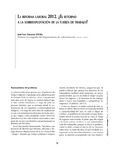| dc.contributor.author | Zarazúa Vilchis, José Luis |
| dc.date.issued | 2013 |
| dc.identifier.uri | http://hdl.handle.net/11191/2594 |
| dc.description.abstract | Este artículo trata acerca del riesgo que conlleva el interés primordial de la reforma a la Ley Federal del Trabajo de procurar el incremento en la productividad del trabajador (como se señaló desde la iniciativa presentada por el ex presidente Felipe Calderón). Por diversas razones. Por una parte, la misma ley define el concepto de productividad de manera tan imprecisa que parece homologarlo con el concepto de la disciplina de administración, además parece dejar en el olvido que los movimientos de lucha obrera y el proceso de institucionalización de los derechos laborales derivados de esos movimientos se originaron como respuesta a ese afán de encontrar formas de hacer más productivo al trabajador que recaen en una sobreexplotación obrera. Con el fin de exponer esta situación problemática se parte de la pregunta central de investigación ¿Por qué la búsqueda de un incremento en la productividad podría conducir nuevamente a la sobreexplotación del trabajador? Y se propone como objetivo describir la manera en que la reforma laboral puede provocar un retorno a la sobreexplotación. Para tratar de responder a esta interrogante, se inicia con un breve recorrido histórico de la lucha obrera a partir de la necesidad de incrementar la productividad y describir cómo se fueron institucionalizando los derechos laborales, posteriormente se procede a definir lo que el concepto de institucionalización implica, para finalizar con el concepto de productividad y la explicación aritmética que responde a la pregunta de investigación. |
| dc.description.abstract | This article is about the risks entailed within the essential interests of The Labor Reform to The Federal Labor Law of increasing employee’s productivity (as pointed out since the initiative designed by former Mexican President, Felipe Calderon). There are many reasons for this: firstly, it is the same law that describes the concept of productivity in a misguided definition, it seems to homogenize the concept from the definition of Administration. Furthermore, it appears to leave aside the working-class struggle movements and prothe process of institutionalization of labor rights, which are the results of those working-class movements, whose origin is the ambition to find as many ways as possible to make their employees more productive that fall back into labor exploitation. In order to explain this problematic situation, we start from the central research question: why finding an increase in productivity could lead again into overexploitation of the worker? The target of this article is to describe the way in which the labor reform could lead to the return of overexploitation. To try to answer this question, we will begin with a brief journey to the worker’s struggle from the need to increase productivity, describe how labor rights were institutionalized, and then proceed to define what the concept of institutionalization implies. Finally, we will revise the definitions of productivity and arithmetic explanation that relate to the central research question. |
| dc.format | pdf |
| dc.language.iso | spa |
| dc.publisher | Universidad Autónoma Metropolitana (México). Unidad Azcapotzalco. |
| dc.source | Gestión y estrategia. Número 44 (julio-diciembre, 2013), ISSN 1606-8459. |
| dc.subject.classification | CIENCIAS SOCIALES::CIENCIAS ECONÓMICAS::ORGANIZACIÓN Y DIRECCIÓN DE EMPRESAS::NIVELES ÓPTIMOS DE PRODUCCIÓN |
| dc.subject.other | Productividad laboral. |
| dc.subject.other | Derecho laboral. |
| dc.subject.other | México -- Política y gobierno -- 2000- |
| dc.title | La reforma laboral 2012: ¿El retorno a la sobreexplotación de la fuerza de trabajo? |
| dc.type | Artículo |
| dc.format.digitalOrigin | Reformatted digital |



